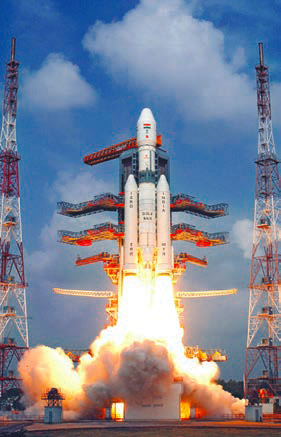Indian Diaspora rejoices the conquest of the Moon

- I.S. Saluja
NEW YORK (TIP) How important is the landing of Chandrayan 3 on the moon on August 23, 2023 can be gauged from the news coverage of the event. All major US newspapers including The New York Times, and the TV channels including the CNN have prominently carried the news . CNN headlined “India becomes the fourth country ever to land a spacecraft on the Moon” . It said: “The mission could cement India’s status as a global superpower in space. Previously, only the United States, China and the former Soviet Union have completed soft landings on the lunar surface.
Chandrayaan-3’s landing site is also closer to the moon’s south pole than any other spacecraft in history has ventured. The south pole region is considered an area of key scientific and strategic interest for spacefaring nations, as scientists believe the region to be home to water ice deposits.
The water, frozen in shadowy craters, could be converted into rocket fuel or even drinking water for future crewed missions. Indian Prime Minister Narendra Modi watched the landing virtually and shared broadcasted remarks on the livestream.
“On this joyous occasion…I would like to address all the people of the world,” he said. “India’s successful moon mission is not just India’s alone. This is a year in which the world is witnessing India’s G20 presidency. Our approach of one Earth, one family, one future is resonating across the globe.
“This human-centric approach that we present and we represent has been welcome universally. Our moon mission is also based on the same human-centric approach,” Modi added. “Therefore, this success belongs to all of humanity, and it will help moon missions by other countries in the future.”
As Chandrayaan-3 approached the moon, its cameras captured photographs, including one taken on August 20 that India’s space agency shared Tuesday. The image offers a close-up of the moon’s dusty gray terrain.
India’s lunar lander consists of three parts: a lander, rover and propulsion module, which provided the spacecraft all the thrust required to traverse the 384,400-kilometer (238,855-mile) void between the moon and Earth.
The lander, called Vikram, completed the precision maneuvers required to make a soft touchdown on the lunar surface after it was ejected from the propulsion module. Tucked inside is Pragyan, a small, six-wheeled rover that will deploy from the lander by rolling down a ramp.
Vikram used its on board thrusters to carefully orient itself as it approached the lunar surface, and it slowly throttled down its engines for a touchdown just after 6 p.m. IST (8:30 a.m. ET) as applause erupted from the mission control room.
The Indian Space Research Organization, or ISRO, later confirmed it had established two-way communication with the spacecraft and shared the first images of the surface captured during the lander’s final descent.
The lander, which weighs about 1,700 kilograms (3,748 pounds), and 26-kilogram (57.3-pound) rover are packed with scientific instruments, prepared to capture data to help researchers analyze the lunar surface and deliver fresh insights into its composition.
Dr. Angela Marusiak, an assistant research professor at the University of Arizona’s Lunar and Planetary Laboratory, said she’s particularly excited that the lunar lander includes a seismometer that will attempt to detect quakes within the moon’s interior.
Studying how the moon’s inner layers move could be key information for future endeavors on the lunar surface, Marusiak said.
“You want to make sure that any potential seismic activity wouldn’t endanger any astronauts,” Marusiak said. “Or, if we were to build structures on the moon, that they would be safe from any seismic activity.”
The lander and rover are expected to function for about two weeks on the moon’s surface. The propulsion module will remain in orbit, serving as a relay point for beaming data back to Earth.
A global moon rush
Working alongside allies such as the United States and France, India is part of a second wave of emerging space powers. The country’s space program has become one of the world’s busiest in its development of exploratory space technology.

Chandrayaan-3 has been a point of national pride and widespread interest across India. Crowds gathered at the launchpad at Satish Dhawan Space Centre in Sriharikota in Andhra Pradesh state to watch the mission take flight in July. On Wednesday, August 23, more than 8 million people tuned in to view a livestream of the landing.
At least 500 people gathered at India’s Council of Scientific and Industrial Research in New Delhi Wednesday where the livestream was broadcast in an auditorium as well as outdoors at a temporary pavilion. After a successful touchdown was confirmed, Indian sweets were distributed to the audience, firecrackers were lit and spectators applauded for more than a minute.
Chants of “Bharat Mata Ki Jai” — or “victory to India” — could be heard, and children joyously waved the Indian flag.
India’s mission has taken on even greater significance since Russia’s failed Luna 25 landing attempt. With the success of Chandrayaan-3, India became the second country to land a spacecraft on the moon in the 21st century after China, which has put three landers on the lunar surface since 2013 — including the first to touch down on the moon’s far side. (The last US lunar lander, the crewed Apollo 17 mission, touched down in 1972.)
More than a dozen countries have plans for missions to the moon in the coming years, including a mission launched by Japan’s space agency — the Japan Aerospace Exploration Agency — that is expected to lift off later this month. The United States also has plans to send three commercial lunar landers to the moon starting as early as this year, while NASA continues to work toward its Artemis III mission, which could put astronauts back on the moon as soon as 2025.
Landing on the moon, however, remains a challenging endeavor. India’s last attempt to land a spacecraft on the moon, during the 2019 Chandrayaan-2 mission, failed. And two commercial spacecraft have crash-landed on the lunar surface in recent times — one from Israel in 2019 and the other from Japan in April.
“There is no doubt that landing on the Moon is a real challenge,” NASA Administrator Bill Nelson said in a statement on Sunday. “But the Moon offers great scientific reward, which is why we’ve seen so many recent attempts to visit the surface again. We’re looking forward to all that we will learn in the future, including from India’s Chandraayan-3 mission.”
On Wednesday, Nelson also shared a congratulatory note on social media, saying, “congratulations to #India on being the 4th country to successfully soft-land a spacecraft on the Moon. We’re glad to be your partner on this mission!”
India is also a signatory of the United States’ Artemis Accords, a document that outlines proposed rules of the road for future lunar exploration. Russia and China have not signed the accords.
The New York Times story emphasizes India being the first country to land a spacecraft on Moon’s Southern Polar Region. The story headlined.
India’s Chandrayaan-3 spacecraft completed a lunar landing, making the country the first to reach the moon’s southern polar region.
The New York Times report says “Two visitors from India — a lander named Vikram and a rover named Pragyan — landed in the southern polar region of the moon on Wednesday. The two robots, from a mission named Chandrayaan-3, make India the first country to ever reach this part of the lunar surface in one piece — and only the fourth country ever to land on the moon.
“We have achieved soft landing on the moon,” S. Somanath, the chairman of the Indian Space Research Organization, said after a roar ripped through the ISRO compound just past 6 p.m. local time. “India is on the moon.”
S. Somanath, the director of the Indian Space Research Organization, had fun deflecting one reporter’s question about the project’s frugal cost. Somanath laughed and said, “I won’t disclose such secrets. We don’t want everyone else to become so cost-effective!” The Chandrayaan-2 was reported to have cost about $46 million, and the Chandrayaan-3 is supposed to have been in a similar range.
Speaking to reporters gathered outside Mission Control, the chairman of ISRO, S. Somanath, told us that the lander’s rover, named Pragyaan, would be rolled out in a matter of hours or, maybe, tomorrow. Its sensors, including a laser and an alpha-particle beam, as well as instruments on the Vikram lander, will start relaying data after that.
As India looks out into the solar system, its space agency is taking a star turn from an earlier era of space exploration. While the national government looks like a hero, private companies that are increasingly important players in the country’s space program operate quietly behind the scenes.
ISRO, the Indian Space Research Organization, was born not long after NASA. In recent years, it has sent robotic orbiters to Mars and the moon and is now preparing to send the first Indian astronauts to space. Based in Bengaluru, the center of the world’s third-largest tech start-up scene, ISRO has bequeathed India a legacy of derring-do in space research.
But the accomplishments of India’s private sector may soon garner as much attention. A younger generation of space engineers, inspired by SpaceX, have started going into business on their own.
And the pace of change is quickening. Prime Minister Narendra Modi’s government wants India to harness the private sector’s entrepreneurial energy to put more satellites and investment into space, faster. That means relegating ISRO to a lower priority.
Mr. Modi hinted at this ambition in June 2020 when he launched IN-SPACe, a government agency headed by a former chairman of India’s biggest multinational automobile company, and assigned it with “space promotion and authorization.” It has become a one-stop shop for India’s private players, as they sign memorandums of understanding with the government and make plans involving ISRO’s spaceport.
This year Mr. Modi’s government published an official space policy that listed IN-SPACe’s role first and gave it more than twice as many priorities as ISRO, which is now to “focus primarily on research and development” and “expanding the human understanding of outer space.”
Outer space is of less interest to commerce, compared with satellites that exchange information with the Earth’s surface, and so the segment left to ISRO seems to be shrinking. While ISRO’s budget in the past fiscal year was less than $1.5 billion, the size of India’s private space economy is already at least $6 billion, and expected to triple as soon as 2025.
India’s main opposition party, the Indian National Congress, joins in the celebrations. “We are deeply indebted to the remarkable hard work, unparalleled ingenuity and unflinching dedication of our scientists, space engineers, researchers,” Mallikarjun Kharge, the party’s president, said.
India has a busy decade of space exploration ahead.

S. Somanath, the director of Indian Space Research Organization, has described the current moment as an inflection point, as the country opens its space programs to private investors after half a century of state monopoly that made advances but at “a shoestring budget mode of working.”
A large share of India’s space efforts in the coming years will focus on the moon.
In addition to the scientific results of Chandrayaan-3, India is preparing a joint lunar exploration with Japan, in which India will provide the lander and Japan the launch vehicle and the rover. The robotic mission, known as LUPEX, is also intended for exploring the South Pole of the moon.
Although an Indian astronaut flew to orbit in 1984, the country has never sent humans to space on its own. It is therefore preparing its first astronaut mission to space, called Gaganyaan. But the project, which aims to send three Indian astronauts to space on the country’s own spacecraft, has faced delays, and ISRO has not announced a date for it.
ISRO will first have to conduct a test flight of the Gaganyaan spacecraft with no astronauts aboard. Officials have said they are at the stage of perfecting the crew escape system, and they said this month that they had tested the drogue parachutes, which help stabilize the capsule that the astronauts will ride as they return to Earth.
Additionally, India is preparing for the Aditya-L1 mission, which plans to study the sun, in early September. ISRO officials have said that it will carry seven payloads to study the photosphere chromosphere and the outermost layers of the sun using electromagnetic and particle detectors.
Another mission is the collaborative NASA-ISRO Synthetic Aperture Radar, or NISAR, which will monitor changes in our planet’s land and ice surfaces from orbit. It is slated to launch from India next year.
The country will also launch a second Mars orbiter mission. The first Mars mission, Mangalyaan, successfully entered the planet’s orbit in 2014 and remained in communication with ISRO until the mission concluded in 2022 when the spacecraft lost power. It made India the first country to achieve Martian orbit on its first attempt, and demonstrated that the country could show scientific prowess even when resources are constrained: The mission’s budget of about $75 million was less than the $100 million budget of the Hollywood space film “Gravity.”
(With inputs from agencies)





Be the first to comment